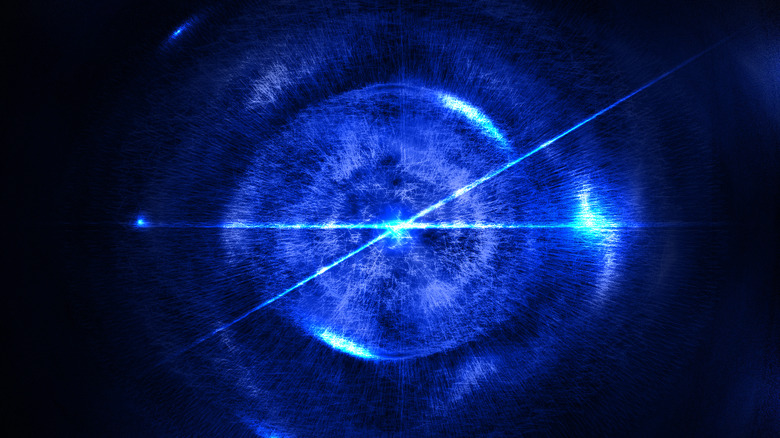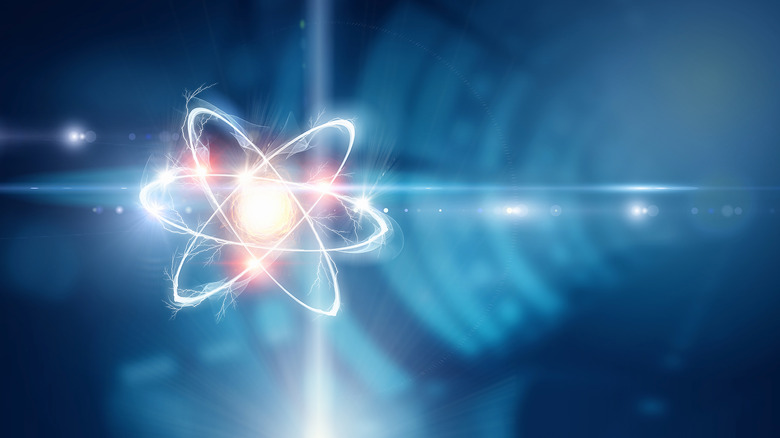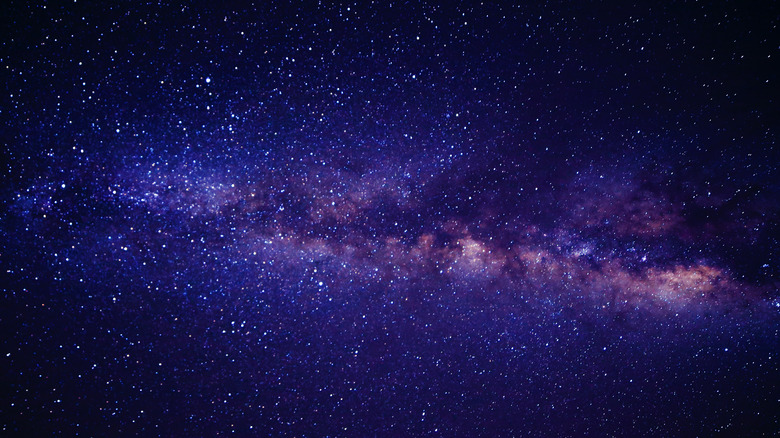The Truth Behind The Existence Of Antimatter
Fans of "Star Trek" will be happy to know that they can recount the factual basics of antimatter with surprising accuracy: a) It's like normal matter, but oppositely charged, b) When it comes into contact with normal matter, enormous amounts of energy are released, and c) It's difficult to contain (Science News for Students has a good summary). In "Star Trek," the Enterprise and other starships control matter-antimatter collisions using dilithium crystals, which powers ships' warp drives. Dilithium, too, is real, but it's not crystalline in structure — it's a gas. Author Dan Brown also wrote antimatter into his thriller "Angels and Demons," when a thief stole one-eighth of a gram of antimatter from Switzerland's CERN research facility to blow up the Vatican. (The University of Geneva says you'd only need one microgram — one millionth of a gram — for such an explosion.)
While antimatter might have gone out of vogue in sci-fi and other genre fiction in favor of "quantum" gobbledygook (spoof available on YouTube), questions about antimatter's existence and origins still plague physicists. If you'd prefer a deep dive right out of the gate, jump into a lengthy debate among researchers such as particle physicist Tara Sheers on the Institute of Art and Ideas' educational site.
Here's the deal: If matter and antimatter annihilate each other, why does our universe of normal matter exist at all? Where did all the now-ultra-rare antimatter go? Such questions cut to the heart of the creation of our 13.8 billion-year-old cosmos.
Antimatter is created by jumps in particle energy levels
The idea of "antimatter" was first postulated by English physicist Paul Dirac in 1928, who went on to win the Nobel Prize in 1933, as described on the CERN website. Basically, he wanted a way to square Einstein's 1905 Theory of Special Relativity (the whole "mass becomes infinite at the speed of light" thing, or "E = mc2," explained on Space) with then-newly uncovered, wait for it ... quantum mechanics (quantum stuff makes an appearance after all). Quantum mechanics claimed that we couldn't know both the position and velocity of subatomic particles until they were measured.
Dirac's equations indicated that energy levels for a particle could be negative, which is impossible unless physicists assume that jumps between energy states occur beneath, and prior to, surface-level measurements. For instance, if an electron jumped into a higher valence shell, Dirac said, it would create a mathematical "hole" of energy, as The Conversation says, that emits a measurable "mirror-image" antimatter particle.
Normal matter (baryonic matter) is composed of protons (positively charged particles), electrons (negatively charged particles), and neutrons (particles without a charge). Antimatter, then, is composed of positrons (negatively charged protons, basically), antielectrons (positively charged electrons), and antineutrons. At its craziest, this opens up the window for mirror-image stars, galaxies, even entire universes composed of antimatter. Lo and behold, Dirac was proven right in 1932 when antimatter was measured in Earth's atmosphere when struck by zipping cosmic rays.
Bananas, nuts, and people all generate antimatter
In the present day, antimatter has become a commonplace fact of physics and of our physical world. "PET" scan stands for Positron Emission Topography (positrons are oppositely charged protons), which generate images of the interior of the human body. For their part, CERN can create antimatter using its 27-kilometer-long Large Hadron Collider (LHC), and also contain it in their Antiproton Decelerator, which, as of 2011, was able to contain antihydrogen for 16 minutes for research purposes, as the CERN website says. This is impressive, because otherwise, antimatter is nearly instantly annihilated on contact with normal matter. CERN has even devoted an entire division, AEgIS, to studying the interactions between antimatter and gravity (also per the CERN website). (A full timeline of CERN's antimatter experiments can be found on New Scientist.)
Heck, even bananas emit antimatter particles, as Symmetry Magazine tells us, because they contain the radioactive isotope potassium-40. So do brazil nuts. And so do people. But don't worry that your body is going to be vaporized after eating a banana because your stomach is emitting positrons. Like we said, antimatter particles vanish almost instantly after they're generated. Besides, only a minute amount of particles are shed each time.
No need to worry about CERN obliterating Earth, either. Creating individual, subatomic particles of antimatter is long and laborious. At present, it would take 100 billion years to create even just one gram of the stuff, as Science Alert says.
Entire antistars could lurk in the Milky Way
So, back to the original problem of antimatter: Where is it all? It exists in such meager quantities, and for such a brief period, that it defies what's known as "CP," or "charge parity," per Symmetry Magazine. Basically, the universe ought to contain an equal amount of oppositely charged particles, and this includes antimatter. But there isn't an equal amount of matter and antimatter in the universe, not by far. Researchers, for awhile, have assumed that the universe started with slightly more normal matter than antimatter, and so the early detonation of the two produced an off-kilter, baryonic universe (per Science News for Students).
That is, unless what we consider "normal" matter is, in fact, the universe-wide outlier. Meaning, perhaps the distribution of antimatter is more densely localized to areas of space beyond the observable universe. After all, as the University of California explains, the 10 billion galaxies that we're able to see and measure, and their 1 billion-trillion stars, accounts for a mere 5% of the entire universe (per NASA). Let that sink in.
There's a lead on this whole "antimatter exists in larger quantities, but we just haven't observed it yet" notion. In 2021, as Science News for Students reports, the journal Physics Review D discovered evidence of entire antistars in our own galaxy. Since we're going to be hanging out in our normal matter region of space for awhile, let's be glad antistars are far away from our sun.



